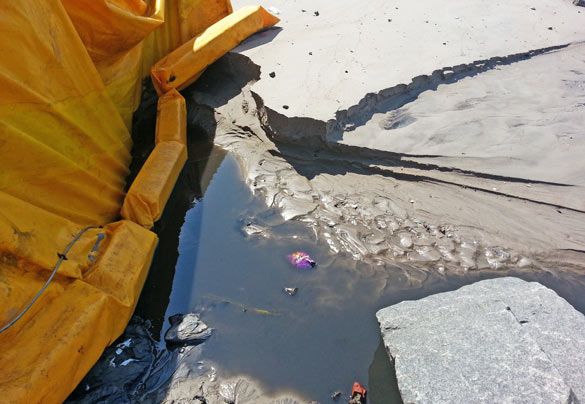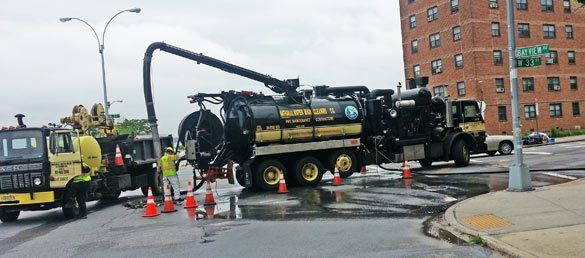Locals Say Toxic Sludge Is Spilling Into Coney Island Creek As City Clears Clogged Sewers

The city’s long-awaited solution to street flooding along the Coney Island peninsula has some locals wondering if the remedy isn’t worse than the disease.

The Department of Environmental Protection is in the midst of a massive clearing operation in western Coney Island, pumping years of sand, debris and residue out of long-jammed sewer lines, which neighbors say caused the streets to flood in even the slightest rain. But now the city is fielding a new set of complaints from residents who say the toxin-filled water is flowing into Coney Island Creek through a combined sewer overflow pipe at West 33rd Street and Bayview Avenue, adjacent to Kaiser Park beach.
“Yes, you’ve got to clean out the drain. But my logic, my god-given common sense, is that you don’t foul it up, you don’t create another foul condition when you solve that problem,” said Pete Castro, a resident of West 35th Street.
Castro has been on the beach almost daily for the past week and a half, filming and taking photos of the Department of Environmental Protection’s private contractor, National Water Main Cleaning Co., as they pump water into the sewer and it flows out of a nearby outfall pipe, onto the beach. The 30-year resident said the water is thick and black with sludge, oil and other contaminants, mucking up a habitat in the midst of a revival.
“I’ve been seeing wildlife come back to the beach, egrets, the occasional swan, ducks go over there. And they’re dumping that oil there and apparently DEP is okay with it,” he said.
The DEP confirmed that they’re clearing out the sewer lines, and that some debris was simply destined to enter the environment.
“We are working to clear out the sand-impacted storm sewers. This is in response to flooding complaints in the area. We have been cleaning out the sewers for weeks and we understand there have been complaints about pumping stuff into the sewer, but in reality this is what we have to do to clean the sewers,” a spokesperson told this outlet.
Despite years of flooding complaints on the Coney Island peninsula, the latest round of work began after a site visit by Superstorm Sandy recovery honchos Bill Goldstein and Amy Peterson. Led by Councilman Mark Treyger, the team visited P.S. 188, where the students and faculty shared the following video showing the extent of flooding outside of the school in even modest rain.
“This is not Sandy, it’s just an average rainstorm,” Treyger told this outlet about the video. “It is a eye-opening video that shows severe flooding that is so bad that a car floated from the street and crashed into the front of the school, that’s how bad the flooding is. We showed the video to Amy Peterson and Bill Goldstein and they were very alarmed by it.”
“It is a damning video that just absolutely validates and confirms portions of Southern Brooklyn had been neglected by the [Bloomberg] administration.”
– Treyger
The Sandy team put pressure on the Department of Environmental Protection to address the flooding immediately. After inspection, the DEP determined that the sewers were clogged near the outfall pipes that go into Coney Island Creek, and dispatched contractors to clear it out.
Treyger admitted that solving one problem for residents caused concern for others. Castro and neighbors made complaints to his office, and he forwarded the video and photos to the DEP for a response.
As a result, Treyger said, the DEP conducted a review, meeting with the contractor and also bringing in the New York State Department of Environmental Conservation, which has jurisdiction over area waterways.
“My sense was that they’re going to review and basically provide greater oversight of the work being done,” said Treyger. “For many years the infrastructure has been an issue here and as we move forward to fix it, we’re not looking to create more environmental disasters. This type of work has to be done in accordance with all environmental regulations and we’re going to make sure that that happens.”

But Castro fears the agencies are being less than thorough in their review. Shortly after Treyger met with the DEP, officials from both the DEP and the DEC spoke directly to Castro about his concerns, assuring him they would investigate the spillage and make sure it was in compliance. But instead of investigation, Castro said he received a call from the DEC rep several hours later saying that they had reviewed the operation and concluded it was safe.
“According to his dubious investigation, some guy [from the DEC] just miraculously put his finger in the air and said it’s okay to put that foul oil onto the beach,” said Castro, adding that there was about six hours between the phone calls – four of which was during hours when the trucks were not pumping. “You can get chemical results like that, with a snap of the finger?”
The DEP spokesperson said she did not know of any specific involvement of the DEC in this matter, but said, “I’m sure we’ve been in touch with DEC at some point.” Asked over the course of multiple phone calls if there was knowledge of the contaminants flowing from the pipe, she said, “I have to double check, but don’t forget it’s the sewer system and it has to get out of the sewers. It can be anything.”
She did not have an answer about contamination when we followed up, instead pointing out that the city uses vactor trucks – essentially giant vacuum cleaners that suck out debris, suggesting that there should be no spillage into the waterway. When we noted that there was spillage, as evidenced by video, she reiterated, “We’re doing work out there.” She did not respond to further questions.
Treyger said he requested the DEP hold a meeting in the community in the upcoming weeks to discuss their operations and respond to potential concerns. He said it will be announced soon.
Until then, Castro said he’ll continue to document the filth and hopes to find someone’s help analyzing water samples. In addition to the wildlife and habitat, he’s also concerned about the numerous indigent locals who turn to Coney Island creek to fish for their meals.
“I can’t see it getting much worse. I’m just waiting for the dead fish to pile up,” he said.




